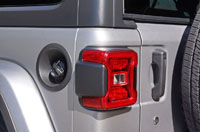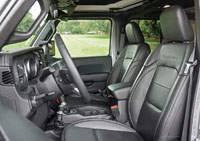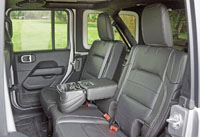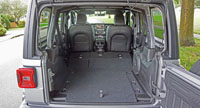
Not to long ago people were calling for the traditional SUV to die. GM cancelled Hummer, Ford said goodbye to the Excursion, and a number of 4×4-capable sport utilities were converted to car-based crossovers in order to appeal to a larger audience. While the general public has certainly eschewed rugged off-roaders as well as passenger cars for crossover SUVs, there’s certainly a healthy niche for true 4x4s.
The 4Runner has been at the centre of this mix, and has been doing so as long as I’ve been out of school. Yes, the 4Runner came into existence the year I graduated in 1981, and is now well into its fifth generation, which was introduced more than a decade ago. The original 4Runner was little more than the pickup truck with a removable composite roof, much like the original Chevy Blazer and second-gen Ford Bronco that came before, but the next version that came in 1989 included a full roof, and the rest of the story is now history.

Over the years Toyota has stayed true to the 4Runner’s off-road-capable character and garnered respect and steady sales for doing so. Now it’s one of a mere handful of truck-based SUVs available, making it high on the shopping list for consumers needing family transportation yet wanting something that can provide more adventure when called upon.
The 2019 model being reviewed here is currently being replaced by a new 2020 model, which changes up the infotainment system with a new larger 8.0-inch touchscreen, Apple CarPlay and Android Auto, satellite radio and USB audio, plus the brand’s Connected Services suite. Push-button ignition gets added too, as does Toyota’s Safety Sense P bundle of advanced driver assistance features including pre-collision system with vehicle and pedestrian detection, lane departure warning and assist, automatic high beams, and dynamic radar cruise control.
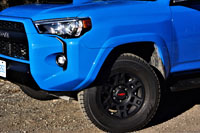
A new Venture trim level gets added as well, which builds on just-above-base TRD Off-Road trim. This means it begins with 4×4 features like 4-Wheel Crawl Control with Multi-Terrain Select, a locking rear differential, and the Kinematic Dynamic Suspension (KDSS) upgrade, while it also gets a hood scoop plus a navigation system with traffic and weather, all before adding black mirror caps, trim, and badging, Predator side steps, 17-inch TRD Pro alloy wheels, and a basket style roof rack.
All of that sounds pretty impressive, but serious off-roaders will still want the TRD Pro that I tested for a week. Not only does it look a lot tougher, particularly in its exclusive Voodoo Blue paint scheme with matte black trim, but it also gets a unique heritage “TOYOTA” grille, a TRD-stamped aluminum front skid plate, a whole lot of black accents and badges nose to tail, and superb looking matte black 17-inch alloys with TRD centre caps on massive 31.5-inch Nitto Terra Grappler all-terrain tires (my tester’s rubber was a set of Bridgestone Blizzak 265/70 studless snow tires).
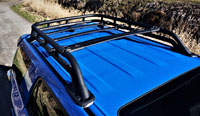
Overcoming obstacles is aided via TRD-tuned front springs and TRD Bilstein high-performance shocks with rear remote reservoirs, while the 4Runner TRD Pro also gets an automatic disconnecting differential to overcome the really rough stuff, as does its rear differential lock if the ground is slippery, and multi-terrain ABS when it’s a downward grade.
Previously noted Crawl Control is ideal for going up, down or just motoring along a low-speed stretch of horizontal terrain, and is selectable via a dial on the overhead console next to a similar dial for the Multi-Terrain Select system that makes choosing the four-wheel drive system’s best possible response over “LIGHT” to “HEAVY” terrain an easy process. Of course, overcoming a really challenging trail will require shifting from “H2” or “H4” to “L4” to engage the 4Runner’s lower set of gears via the console-mounted 4WD Selector lever.
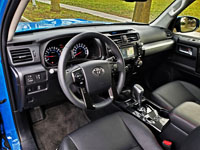
This SUV is an amazingly good 4×4, something I was reminded of when trudging through a local off-road course I use whenever I have something worthy of its rutted trails and long, deep swampy pools. I recently tested Jeep’s Wrangler Unlimited Sahara through this course, and did likewise with a Chevrolet Colorado ZR2 turbo-diesel that had mucky water splashing over its hood. Heck, I even proved that Toyota wasn’t trying pull one over on compact crossover buyers with its new RAV4 Trail, that can actually hold its own through this mud-fest, although I didn’t push it anywhere near as hard as the others just mentioned, or this 4Runner TRD Pro.
My 4Runner test model’s hood scoop never tasted water, incidentally, nor did it ever require the Tacoma TRD Pro’s cool looking snorkel, and trust me, I was careful not to muck up the white and red embroidered floor mats, or even soil the breathable leather-like Black SofTex seat upholstery, highlighted by red contrast stitching and red embroidered “TRD” logos on the front headrests I should add. It would have been easy enough to wash off, but I keep my test vehicles clean out of respect to the machinery.

This 4Runner TRD Pro makes it easy to drive through most any 4×4 course or wayward trail, even if there’s not much drive down. Simply choose the best Multi-Terrain setting and engage Crawl Control if you think you’ll want to push yourself up higher in the driver’s seat in order to see over a ridge, which would make it so you couldn’t modulate the gas pedal. Alternatively you can use it in order to relax your right foot, like a cruise control for ultra-slow driving. We had a mechanical version of this on my dad’s old Land Cruiser FJ40, which was basically a choke that held the throttle out, and it worked wonders just like the 4Runner’s modernized version. The now discontinued FJ Cruiser had one too, a model that shared its platform with this much bigger and more spacious SUV, as does the global market Land Cruiser Prado and Lexus GX 460.
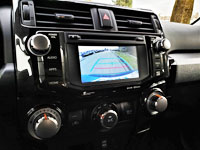
V8-powered 4x4s in mind, I remember when Toyota offered the fourth-generation 4Runner with a 4.7-litre V8. I really liked that truck and its smooth, potent powertrain, but I’d rather have the 2.8-litre turbo-diesel found in the current Prado, as it’s fuel economy would be advantageous in the city and on the highway, let alone in the wilderness where it could 4×4 a lot farther from civilization than the current 4.0-litre V6. Yes, the 4Runner’s big six-cylinder drinks healthily to put it kindly, with a rating of 14.3 L/100km city, 11.9 highway and 13.2 combined, while it goes through even more regular unleaded in low gear while off-roading. That’s this SUV’s only major weakness, and now that Jeep is bringing its Wrangler to our market with a turbo-diesel, and the aforementioned Chevy Colorado gets one too, it’s might be time for Toyota to provide Canadian off-road enthusiasts an oil burner from its global parts bin.
Another weakness at the pump is the 4Runner’s five-speed automatic transmission, but on the positive it’s rugged and reliable so it’s hard to complain, while shifts smoothly. The TRD Pro adds red stitching to the leather shift knob, almost making this gearbox feel sporty when engaging its manual mode, and I should also commend this heavyweight contender for managing the curves fairly well, no matter if it’s on tarmac or gravel, while its ride quality is also quite good, something I appreciated as much in town as I did on the trail.
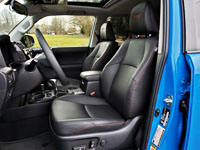
I would have appreciated the 4Runner even more if it included shock-absorbing seats like my old ‘86 Land Cruiser BJ70, but the TRD Pro’s power-actuated seats with two-way powered lumbar managed comfort decently enough, while the SUV’s tilt and telescoping steering column provided enough reach to set up my driving position for comfort and control.
The steering wheel’s rim is wrapped in leather, but doesn’t get the nice red stitching from the shift knob, yet its spokes are filled with all the most important buttons. Framed through its upper section, the Optitron primary gauge cluster is a comprised of truly attractive blues, reds and whites on black with a small trip computer at centre.
At dash central, the infotainment touchscreen may be getting replaced for the 2020 model year, but the one in this 2019 4Runner was certainly sized large enough for my needs, plus was reasonably high-resolution and packed full of stylish graphics and loads of functions. Its reverse camera lacked active guidelines, but was quite clear, while the navigation system’s route guidance was accurate and its mapping system easy to read, plus the audio system was pretty good as well.

The 4Runner’s window seats are comfortable and the entire second row amply sized for most any body type, but the TRD Pro model’s third row gets axed, leaving plenty of room for gear. There’s in fact 1,337 litres of space behind the 60/40-split second row, or up to 2,540 litres it’s lowered, making the 4Runner ideal for those that regularly haul tools or other types of equipment, campers, skiers, etcetera.
You can buy a new 2019 4Runner for $46,155 or less (depending on your negotiating chops), while leasing and financing rates can be had from 1.99 percent (or at least they could at the time of writing, according to the 2019 Toyota 4Runner Canada Prices page here at CarCostCanada). CarCostCanada also provides its members with money saving rebate info and dealer invoice pricing that could save you thousands, so be sure to purchase a membership before you head to the dealer. As for the 2020 4Runner, which starts at $48,120 thanks to the new equipment I detailed out before, only has leasing and financing rates from 4.49 percent as seen on the CarCostCanada 2020 Toyota 4Runner Canada Prices page, so the 2019 may be the smart choice for those on a budget. If you’re after this TRD Pro, you’ll be forced to find $56,580 plus freight and fees (less discount), and take note this is the most expensive 4Runner trim available.
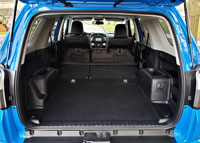
Yes this is luxury brand territory, and the 4Runner won’t try to dazzle you with soft-touch interior plastics or any other pampering premium treatments, but this should be okay because it’s a rugged, off-road capable 4×4 that shouldn’t need to pamper its passengers to impress them. Instead, together with its superb off-road-worthiness, overall ease of use and general livability, the 4Runner achieves top placement in the 2019 Canadian Black Book Best Retained Value Awards for its “Mid-size Crossover-SUV” category. I don’t know about you, but this matters more to me than pliable interior composite surfaces.
In the end, the 4Runner remains one of my favourite SUVs. It does most everything it needs to well, and is one of the better off-roaders available for any money. That suits my outdoor lifestyle to a tee.
Story and photo credits: Trevor Hofmann




